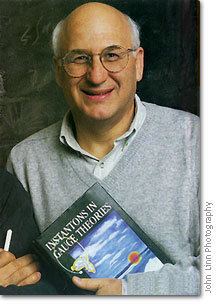Academic advisors Boris L. Ioffe Name Mikhail Shifman | Role Physicist | |
 | ||
Fields Theoretical High Energy Physics Institutions William I. Fine Theoretical Physics Institute, University of MinnesotaInstitute for Theoretical and Experimental Physics (ITEP) Known for Penguin mechanismQuantum ChromodynamicsInvisible axionNonperturbative supersymmetrySupersymmetric gauge theories Notable awards Humboldt Research Award (1993)Sakurai Prize (1999)Lilienfeld Prize (2006)Chaires Blaise Pascal (2007)Pomeranchuk Prize (2013) Books ITEP Lectures on Particle Physics and Field Theory | ||
Mikhail Shifman-Ten-dimensional critical string as a soliton in four- dimensional super
Mikhail "Misha" Arkadyevich Shifman (Russian: Михаи́л Арка́дьевич Ши́фман; born 4 April 1949) is a theoretical physicist (high energy physics), formerly at Institute for Theoretical and Experimental Physics, Moscow, currently Ida Cohen Fine Professor of Theoretical Physics, William I. Fine Theoretical Physics Institute, University of Minnesota.
Contents
- Mikhail Shifman Ten dimensional critical string as a soliton in four dimensional super
- 2016 Dirac Medal Award Ceremony
- Scientific contributions
- Honors and awards
- Selected books
- References
2016 Dirac Medal Award Ceremony
Scientific contributions
Shifman is known for a number of basic contributions to quantum chromodynamics, the theory of strong interactions, and to understanding of supersymmetric gauge dynamics. The most important results due to M. Shifman are diverse and include (i) the discovery of the penguin mechanism in the flavor-changing weak decays (1974); (ii) introduction of the gluon condensate and development of the SVZ sum rules relating properties of the low-lying hadronic states to the vacuum condensates (1979); (iii) introduction of the invisible axion (1980) (iv) first exact results in supersymmetric Yang-Mills theories (NSVZ beta function, gluino condensate,1983–1988); (v) heavy quark theory based on the operator product expansion (1985–1995); (vi) critical domain walls (D-brane analogs) in super-Yang-Mills (1996); (vii) non-perturbative (exact) planar equivalence between super-Yang-Mills and orientifold non-supersymmetric theories (2003); (viii) non-Abelian flux tubes and confined monopoles (2004). His paper with A. Vainshtein and Zakharov on the SVZ sum rules is among the all-time top cited papers in high-energy physics.
Honors and awards
Mikhail Shifman received the Alexander-von-Humboldt Award in 1993, the Sakurai Prize in 1999, the Ida Cohen Fine Chair in Theoretical Physics and the Julius Edgar Lilienfeld Prize in 2006; he is the 2007 laureate of the Blaise Pascal Chair, 2013 Pomeranchuk Prize and he was awarded the 2016 Dirac Medal and Prize. Shifman is also a Fellow of the American Physical Society.
